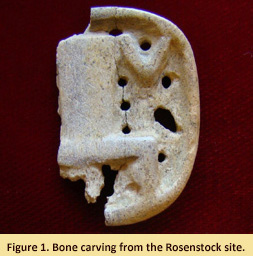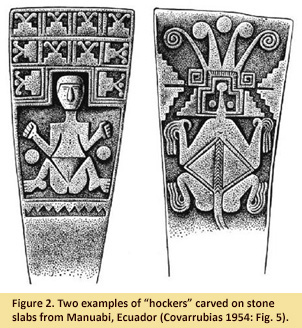A Carved Bone Figure
May 2010
By Dennis C. Curry and Maureen Kavanagh, Maryland Historical Trust
 The Rosenstock site (18FR18) is a large Late Woodland village located in Frederick County, Maryland. Staff from the Maryland Historical Trust's Office of Archeology, in cooperation with the Archeological Society of Maryland, Inc., carried out exploratory testing at the site in 1979, and undertook more extensive excavations in 1990-1992. These excavations revealed a circular village pattern typical of the Montgomery Complex - an open central plaza surrounded by a ring of trash-filled pits (originally used for storage), which in turn were encircled by a ring of single-family, small, oval houses (see Curry and Kavanagh 2004). Some Montgomery Complex villages were enclosed by a palisade, but no evidence for such structure was found at Rosenstock.
The Rosenstock site (18FR18) is a large Late Woodland village located in Frederick County, Maryland. Staff from the Maryland Historical Trust's Office of Archeology, in cooperation with the Archeological Society of Maryland, Inc., carried out exploratory testing at the site in 1979, and undertook more extensive excavations in 1990-1992. These excavations revealed a circular village pattern typical of the Montgomery Complex - an open central plaza surrounded by a ring of trash-filled pits (originally used for storage), which in turn were encircled by a ring of single-family, small, oval houses (see Curry and Kavanagh 2004). Some Montgomery Complex villages were enclosed by a palisade, but no evidence for such structure was found at Rosenstock.
During the 1979 testing, a small portion of a trash-filled pit (Feature 5) was uncovered and partially excavated. This trash pit - filled with Shepard ware (collared ceramics similar to Owasco ware in New York), stone artifacts, and animal bone tools and waste - ultimately proved to be a deep, double-bottomed feature containing some 12 cubic meters of fill which required three field seasons to completely excavate. It was during flotation of the feature fill excavated in 1991 that an unusual bone carving was recovered (Figure 1).
 The figure is carved in bas-relief on bone (presumably a deer epiphysis) and appears to represent a headless human effigy. The artifact is broken along its left side, following the carved edge of the figure's torso. The perforating holes surrounding the figure are drilled from both sides, although two (near the figure's "calf") were started only on the carved face and not completed. It is unclear whether the large hole on the right was intentional, or if it was an intended small hole that "punched out." It is also unclear whether the holes were intended as part of the decorative motif, or whether they were drilled in preparation for removal of background material in filigree fashion.
The figure is carved in bas-relief on bone (presumably a deer epiphysis) and appears to represent a headless human effigy. The artifact is broken along its left side, following the carved edge of the figure's torso. The perforating holes surrounding the figure are drilled from both sides, although two (near the figure's "calf") were started only on the carved face and not completed. It is unclear whether the large hole on the right was intentional, or if it was an intended small hole that "punched out." It is also unclear whether the holes were intended as part of the decorative motif, or whether they were drilled in preparation for removal of background material in filigree fashion.
A charcoal sample from the level at which the bone figure was recovered was radiocarbon-dated to A.D. 1040±90, or a mean calibrated date of A.D. 1125. Four additional samples from the double pit produced mean calibrated dates ranging from A.D. 1190 to 1460. The disparity among dates from this pit is confusing, both in terms of this artifact and the site as a whole. Based on the predominance of Shepard ceramics at the site, the earlier dates would seem appropriate, while the 15th century dates are perhaps more likely for this particular artifact (see below).
![Image of a bone comb with "hockers" from a Seneca Iroquois site (Wray 1963:Plate 3[13]).](/PublishingImages/mac-Lab/curators-choice/2010/2010-05/figure3-bone-comb-with-hockers.jpg) Intrigued by the unique nature of this artifact, and unable to find comparable specimens in readily available literature, we sent a sketch and description to several dozen colleagues in eastern North America, asking for information on similar examples. The answer came from Robert Funk and George Hamell of the New York State Museum. The squatting figure is termed a “hocker,” and is found throughout the world, including China, Southeast Asia, Oceania, Mexico, Peru, and the Northwest Coast (Covarrubias 1954) (Figure 2). Hockers are apparently rare east of the Mississippi River, although they are common in Seneca Iroquois art (especially on bone combs) during the period from 1670 to 1700 (Wray 1963; Hamell 1979) (Figure 3). Funk reports that - even at ca. A.D. 1460 - our specimen would represent one of the earliest hockers ever found in the East. Hamell states that the earliest specimen he is aware of comes from the Northern Iroquoian region of New York. The specimen consists of continuous bas-relief hockers (a frog alternating with a headless human) around the bowl of a ceramic elbow pipe, representative of Canandaigua Phase Owasco, ca. A.D. 1130.
Intrigued by the unique nature of this artifact, and unable to find comparable specimens in readily available literature, we sent a sketch and description to several dozen colleagues in eastern North America, asking for information on similar examples. The answer came from Robert Funk and George Hamell of the New York State Museum. The squatting figure is termed a “hocker,” and is found throughout the world, including China, Southeast Asia, Oceania, Mexico, Peru, and the Northwest Coast (Covarrubias 1954) (Figure 2). Hockers are apparently rare east of the Mississippi River, although they are common in Seneca Iroquois art (especially on bone combs) during the period from 1670 to 1700 (Wray 1963; Hamell 1979) (Figure 3). Funk reports that - even at ca. A.D. 1460 - our specimen would represent one of the earliest hockers ever found in the East. Hamell states that the earliest specimen he is aware of comes from the Northern Iroquoian region of New York. The specimen consists of continuous bas-relief hockers (a frog alternating with a headless human) around the bowl of a ceramic elbow pipe, representative of Canandaigua Phase Owasco, ca. A.D. 1130.
In their study of ancient symbolism, Schuster and Carpenter (1996:82-83) view hockers - especially when used as part of a repeated design - as an element depicting genealogy. Each hocker represents an ancestor, and the headless nature of some hockers is seen as deliberate and symbolic, i.e., ancestors, in general, are dead. They (Schuster and Carpenter 1996:104, 113) also discuss the use of "excerpts" where a single figure taken from a genealogical pattern is used as a medallion and, in some societies, assigned the name of a deceased person.
Other interpretations were offered as well. It is possible that the raised rim of the Rosenstock carving represents a metaphorical door of a house, and that the hocker serves as a "doorkeeper," again an Iroquoian notion (Hamell 1979, personal communication 1992). Edmund Carpenter (personal communication, 1992) notes that it is possible that the holes surrounding the figure represent "joint marks" used in divination by cultures in both Americas.
While the possible social symbolism of the Rosenstock hocker is purely speculative, it does provide some context for considering its possible function and meaning. In truth, however, the meaning of this carving may never be known.
| References |
|
| Covarrubias, Miguel |
| 1954 |
The Eagle, the Jaguar, and the Serpent: Indian Art of the Americas. Alfred A. Knopf, NY. |
|
| Curry, Dennis C., and Maureen Kavanagh |
| 2004 |
Excavations at the Rosenstock Village Site (18FR18), Frederick County, Maryland: A Preliminary Report. Maryland Archeology 40(1):1-38. |
|
| Hamell, George R. |
| 1979 |
Of Hockers, Diamonds and Hourglasses: Some Interpretations of Seneca Archeological Art. Paper presented at the Annual Conference on Iroquois Research, October 13-15, 1979, Albany, NY. |
|
| Schuster, Carl and Edmund S. Carpenter |
| 1996 |
Patterns that Connect: Social Symbolism in Ancient and Tribal Art. Harry N. Abrams, Inc., NY. |
|
| Wray, Charles F. |
| 1963 |
Ornamental Hair Combs of the Seneca Iroquois. Pennsylvania Archaeologist 33(1-2):35-50. |
|